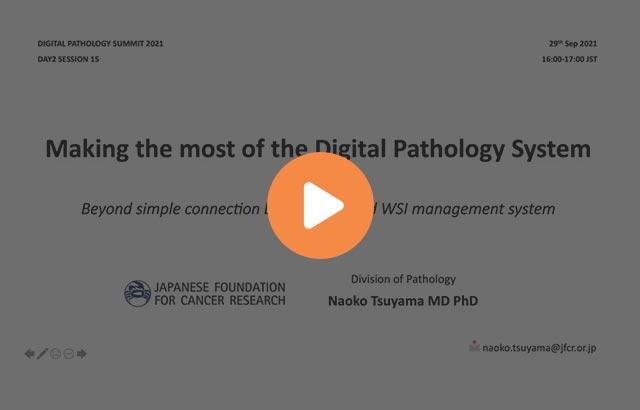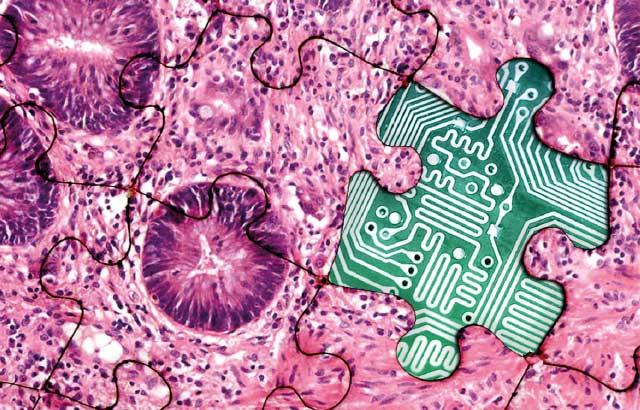
The Chasm Between Traditional and Digital Pathology

The roots of digital imaging stretch back to 1957 when the first digital image was produced by a team led by engineer and computer scientist, Russell Kirsch, who at the age of 27 used a newly invented “drum” scanner to create a digital image of his newborn son. The first video microscopy event would not occur until a decade later when peripheral blood smears were transmitted between a medical station in Boston’s Logan International Airport to Massachusetts General Hospital in 1968.
Digital imaging in medicine has come a long way since then with numerous technology advances and global adoption in many clinical care settings. Digital imaging in Anatomic Pathology has also advanced significantly but remains among the last of the medical fields to undergo a complete digital transformation. Today, most anatomic pathology laboratories, including those in technologically advanced regions, continue to rely on time-tested microscopes to render diagnoses. The reasons for this are multifactorial, but suffice to say that now there appears to be a convergence of many factors that are accelerating the digital transformation.
A roadmap for technology adoption, including pathology’s digital journey, can be found in Geoffrey Moore’s Crossing the Chasm, which details a framework for widespread adoption of novel technologies. Author Geoffrey Moore defines technology ‘pragmatists’ as a cohort which prioritizes quality, the existence of supporting infrastructure, and reliability. These pragmatists are compelled to action when the market has responded favorably because all these areas have been addressed. Early adopters or visionaries on the other hand are not as risk averse. Visionaries in the field of digital pathology have had to wait decades for the point where we now find ourselves. I believe the momentum around digital pathology has increased to the point where Moore’s pragmatists are now ready to move forward.
Recently I participated in a panel to examine the digital transformation of pathology labs and practices, along with Dr. Kyoung Bun Lee and Dr. Cory Roberts. Though we work at different types of organizations in different parts of the world, we share the perspective that we are at the precipice of change and widespread acceptance of digital. A culmination of factors, including technology performance, cost, new needs (in the setting of a global pandemic), and the promise of game-changers, like Artificial Intelligence/Machine Learning (AI/ML), has resulted in inexorable transformation towards digital pathology across the globe. At the same time many of the same challenges that have slowed adoption remain as a thorn in the side of progress. One such thorn is the lack of standardization.
We should introduce standards wherever we can, from operating procedures to slide labeling to image formats and image annotation. While there's been sustained efforts towards standardization in digital pathology, fragmentation in the market persists. It behooves us to put a lot of thought and thought leadership into how digital transformation can be optimized through interoperability and standardization efforts. In many cases, this necessitates vendors coming together to propose the best ways their systems can interoperate with other IT systems, whether it be an electronic health record, a laboratory information system, an image management system or pathology PACS, or other equipment. All need to work together to fulfill pathology and hospital requirements.
Dr. Lee, whose hospital in Seoul has deployed digital and computational pathology, noted it was difficult in her institution to prompt change from traditional pathology methods until the team had full confidence to render diagnoses using digital monitors. To achieve this evolution, the department validated and established a policy to standardize how to render diagnoses viewing digital images on monitors. This action compelled pathologists and laboratory technicians to alter their practice patterns, eventually acclimating to a monitor’s expansive field of view and gaining comfort with how H&E colors look on a monitor versus through a microscope. For histotechnicians, the policy elevated the importance of ensuring slides were optimized for digital reads.
Dr. Roberts believes that within 10 years drivers for digital pathology will have transformed his practice, allowing pathologists to work wherever they choose and enhance the diagnoses they provide. Simultaneously the transformation will drive centralization of histopathology and digital scanning services. Optimal selection of efficient vended solutions to aid in this transformation benefits from industry standardization. The creation of smart, sustainable standards requires we engage with all relevant stakeholders in the pathology ecosystem. Dr. Roberts was spot on when he remarked during the panel session that we need digital to be a priority across our organizations, from the C-suite to IT to clinicians and laboratory professionals, because there are a lot of things that go into a digital transformation. It's all doable, he went on to say, but broad buy-in is vital. I wholeheartedly concur.
For most of us, AI/ML is further down the digital journey. However, it is timely to consider AI/ML-specific procedures and policies in parallel to digital pathology. All the challenges we have with standardization and interoperability of digital pathology remain present for AI/ML. For example, unstructured text and structured/discrete data from a clinical record contains content relevant to pathology. While not all organizations will integrate that data in the same way, we need standards for how text, numerical, and image-based data is captured, stored, and transmitted to foster interoperability amongst vended solutions.
I believe pathology is getting it right leading with standardization of policies, procedures, and technologies. Digital transformation is exciting, achievable and reliant on us working in concert as a profession to realize its potential.
About the presenter

Dr. Dash is a board certified pathologist recognized worldwide for his laboratory informatics expertise. He is co-chair of Integrating the Healthcare Enterprise (IHE) Anatomic Pathology and active on a number of national committees including serving on a number of technology related committees for the College of American Pathologists.
He is director for laboratory informatics for Duke University Health System in Durham NC. Dr. Dash has over 26 years of diverse experience in Pathology, with a focus on breast cancer diagnostics, cytopathology, and laboratory informatics. Dr. Dash is American Board of Pathology certified in Anatomic & Clinical Pathology, Cytopathology and Clinical Informatics.
Related Content
El contenido de Leica Biosystems Knowledge Pathway está sujeto a las condiciones de uso del sitio web de Leica Biosystems, disponibles en: Aviso legal.. El contenido, incluidos los webinars o seminarios web, los recursos de formación y los materiales relacionados, está destinado a proporcionar información general sobre temas concretos de interés para los profesionales de la salud y no está destinado a ser, ni debe interpretarse como asesoramiento médico, normativo o jurídico. Los puntos de vista y opiniones expresados en cualquier contenido de terceros reflejan los puntos de vista y opiniones personales de los ponentes/autores y no representan ni reflejan necesariamente los puntos de vista ni opiniones de Leica Biosystems, sus empleados o sus agentes. Cualquier enlace incluido en el contenido que proporcione acceso a recursos o contenido de terceros se proporciona únicamente por comodidad.
Para el uso de cualquier producto, debe consultarse la documentación correspondiente del producto, incluidas las guías de información, los prospectos y los manuales de funcionamiento.
Copyright © 2025 Leica Biosystems division of Leica Microsystems, Inc. and its Leica Biosystems affiliates. All rights reserved. LEICA and the Leica Logo are registered trademarks of Leica Microsystems IR GmbH.



